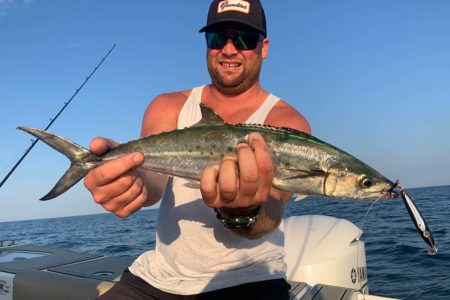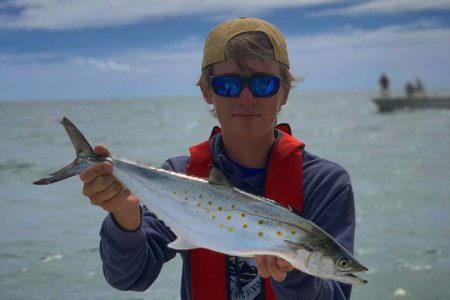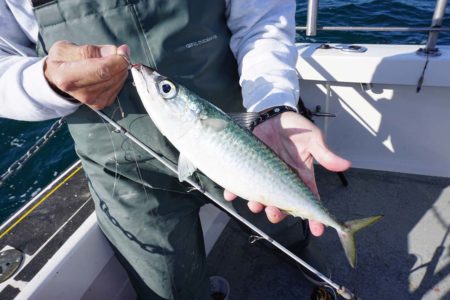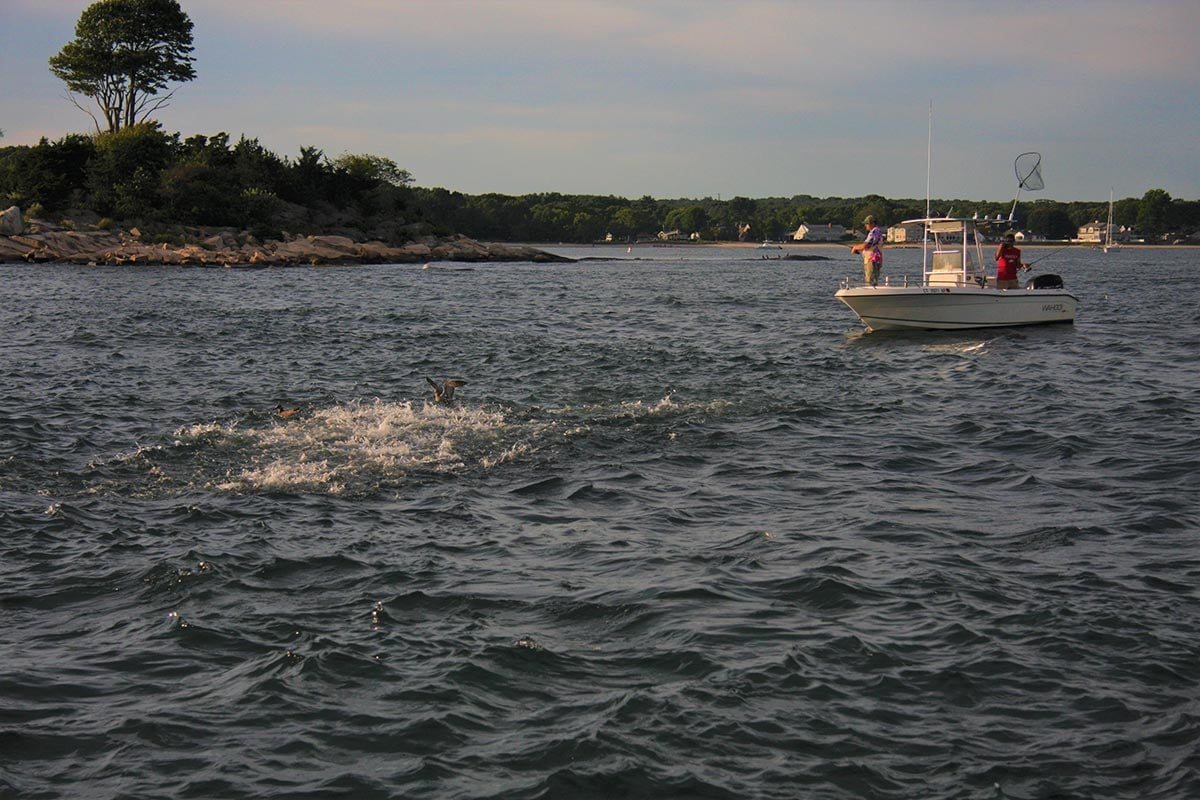
Warm-water mackerel add great sport to the summer doldrums. Here’s what you need to know about this new arrival.
Unlike Atlantic mackerel, which frequent cooler waters from Block Island to Maine, chub mackerel tolerate warmer water and migrate north into southern New England as the summer heat raises water temperatures. This recent phenomenon, like the increase in black sea bass, may be linked to climate change or it may be just a cyclical population fluctuation and shift. Anglers often report schools of chubs in the canyons, but recently these speedsters have invaded inshore waters. Last summer saw numerous, large schools of chubs delighting both beach and small-boat anglers eager for hot action and fresh fish during the August doldrums.
“As I trudged onto a Rhode Island beach one afternoon last summer,” said lifelong saltwater angler Elliott Taylor, “I was greeted by a couple of defeated old-timers sitting and staring at the calm surf. ‘Bonito. Too far out though,’ is all they said while I dragged my kayak past them and into the water.
“As I paddled towards one of my favorite nearshore reefs, I was suddenly interrupted by an acre of boiling water as a feeding frenzy materialized. The splashes were circular and tight, unlike the slashing breaks of albies or bonito. Before I could rig up and fire a cast, they vanished. I waited patiently for the school to resurface with my finger on the trigger. I heard the blitz erupt again to my left and cast a 1-ounce Deadly Dick and teaser into the middle of the blitz. I was on! The fight was like a small bluefish but faster, yet not quite the drag-screaming battle of a bonito. It was exciting! But I still didn’t know what I had hooked.”
What are They?
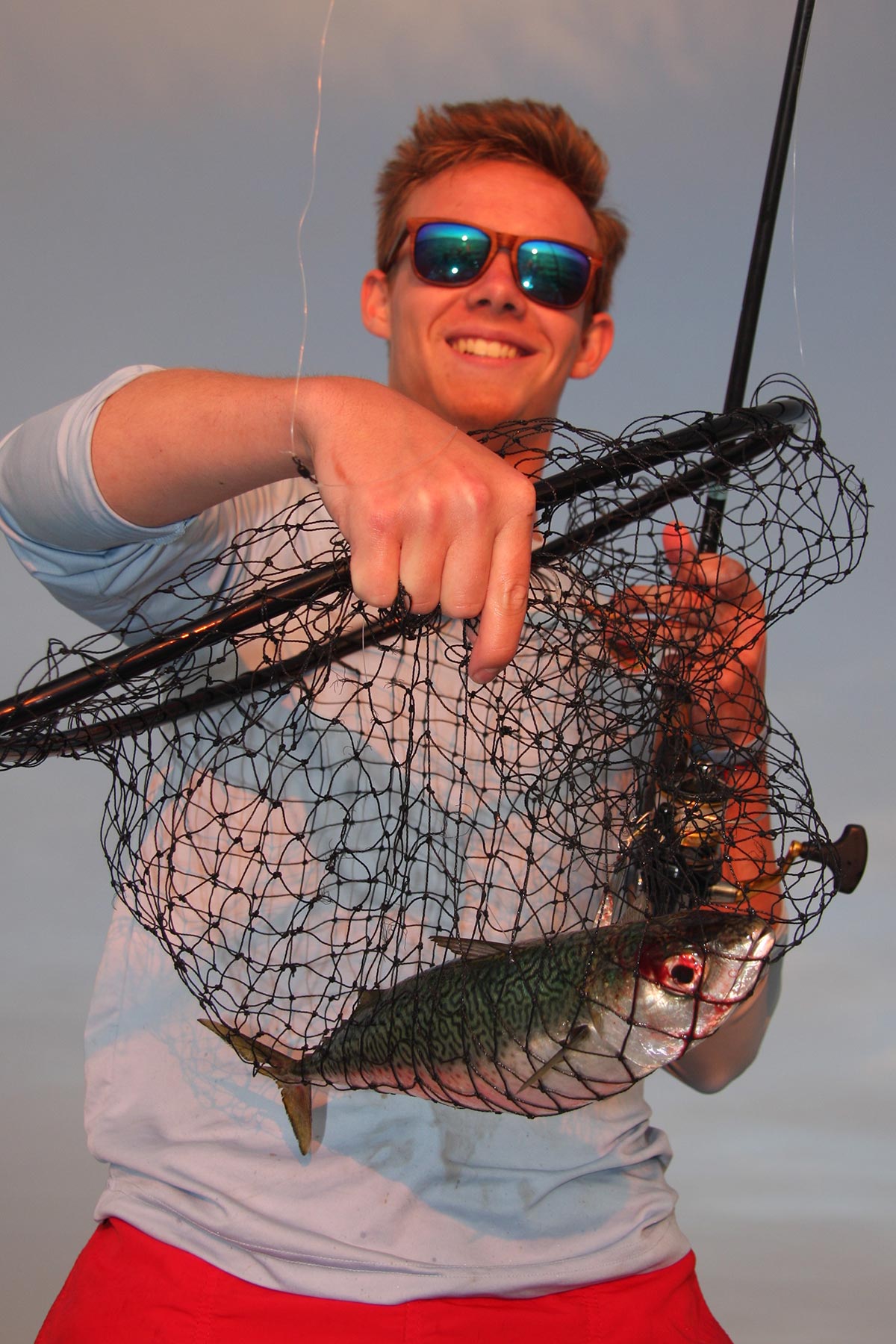
Chub mackerel (Scomber colias), also known as hardhead and bullseye mackerel, are not to be mixed up with our common spring-run Atlantic mackerel (Scomber scombrus) or the bullet mackerel (Auxis rochei). The chub so closely resembles the common mackerel that they’re easily confused in hand.
From a distance, many southern New England anglers, unfamiliar with the identifying trademarks of chub mackerel blitzes (or Atlantic mackerel, for that matter), immediately assume they’re witnessing harbor bluefish, false albacore or bonito. One of my trips to the Niantic ramp last summer, like Taylor’s experience, was another example of the misconception.
As I was launching, I heard from a couple guys returning that “schools of bonito were in Niantic Bay and outside Jordan Cove.” I spotted the schools soon after my arrival, but they were not tunoids. These bunches were densely packed and frothing with fish numbering in the thousands—clearly unlike our typical pods of bonito.
Chub mackerel are “chubbier” or more rotund than Atlantic macks, and they also sport a larger eye. Common Atlantic mackerel are silvery-sided below their midline, whereas chub mackerel are mottled with small, dusky blotches or spots below their midline. Other differences include the chub’s dorsal fins are closer together, and they have only 9 or 10 spines in their first dorsal fin compared to 11 or more in the Atlantic mackerel. The chub is a smaller fish than its common relative, growing to a length of about 14 inches.
The flesh of the chub mackerel is rich and oily like other mackerels and tunas, and fresh it’s a choice table fish in the skillet, on the grill or smoked; however, it does not freeze well and becomes softer and significantly stronger after only a couple days in the refrigerator. Bleed and ice them immediately from the water, especially in the summer heat. The chub’s biomass is not commercially overharvested as is the Atlantic mackerel’s, which has been overfished for a decade, even though the chub is harvested and sold canned worldwide.
There’s also a Pacific chub mackerel (Scomber japonicus), which closely resembles the Atlantic chub mackerel, inhabiting warm West Coast waters. However, they’re now considered an invasive species in British Columbia, Canada, which have been moving north from southern waters because of warming currents related to climate change. These mackerel eat salmon fry (baby salmon), and are one of the reasons attributed to the declining Pacific salmon population. The chub mackerel is an old species; paleontologists have found their fossils in Italy from the Pliocene epoch or about 2.2 to 3 million years ago.
Chub mackerel and bonito are sometimes also confused with Spanish mackerel. The Spanish mack features a green back with silvery sides sporting about three rows of irregular golden-yellow spots. The first dorsal fin is black at the front. It boasts a row of cutting-edged teeth in each jaw that are large, uniform, closely spaced and flattened.
“When I finally got a glimpse of my catch,” said Taylor, “I realized I had doubled-up on something that were neither bluefish nor bonito. The thin, streamlined body resembled a tuna species, but not one I had encountered before. The fish had large eyes, no teeth and a delicate mouth. After some quick research on my phone, I finally determined they were chub mackerel. I could see how these fish could be confused for bonito based on speed alone, but their feed-mode surface splashes were extremely tight, almost as if they were being chased by predators. I put a couple on ice, and they were great on the grill that night.”
Historical Fluctuations
Chub mackerel were extremely abundant in our region during the last of the 18th century and early years of the 19th century through about 1830. Capt. E. E. Merchant, an experienced and observant fisherman, described these mackerel as so plentiful off Provincetown from 1812 to 1820 that “three men and a boy could catch 3,000 in a day by hook and handline.” But the species disappeared entirely from the East Coast between 1830 and 1850.
Chub mackerel reportedly started showing in large numbers along the Jersey coast in 2014, while head boats were targeting other species like small bluefish. When the head boat mates started chumming in waters about 50 to 60 feet deep, the forage would often draw in large schools of chubs. Some party boats considered them a pest while others welcomed them as a save-the-day species, and they were particularly fun when mixed-in with small blues. Some customers specifically took head-boat trips targeting chubs.
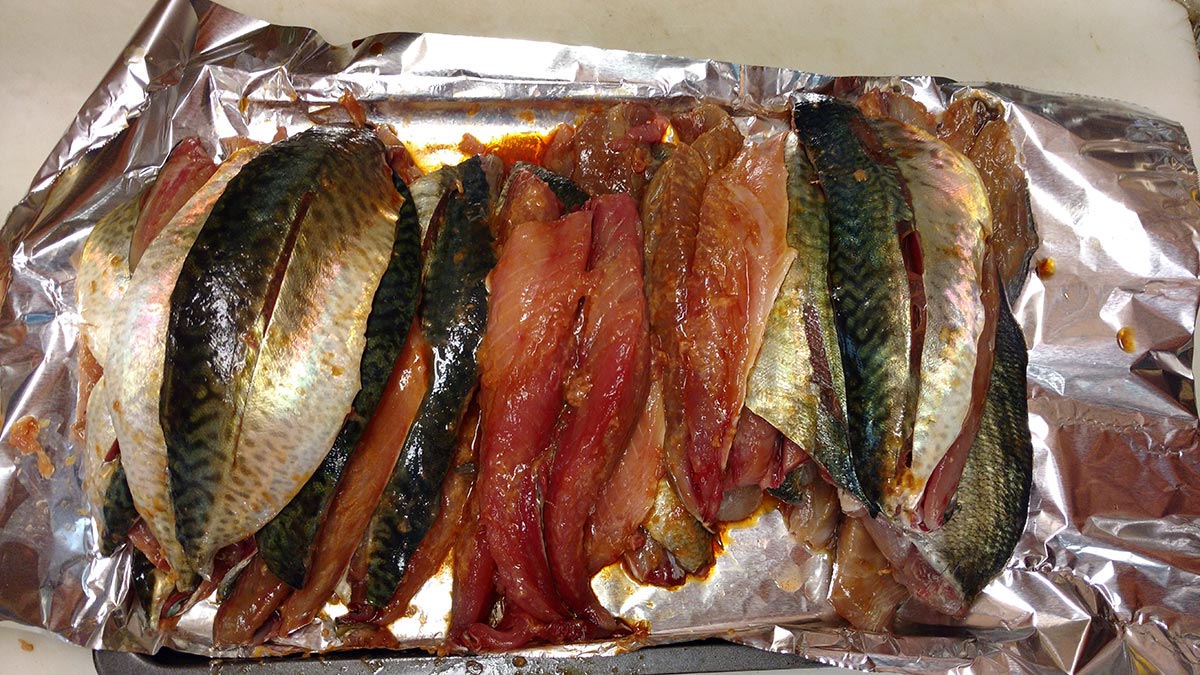
Where to Find Them
Unless you have recent, reputable reports of chub mackerel staging in a specific area, it’s difficult to plan a trip just targeting them. The smart angler accounts for chub mackerel not by endlessly patrolling the 30- to 60-foot contour off the beaches starting in late July; rather, he keeps a couple of spare light-spinning rods rigged and ready in rodholders. When the fish bust on top, he needs to determine what he’s looking at in terms of species—distinguishing chubs from, say, feeding schoolie bass or adult bunker being marauded by bluefish—and be ready to fire a cast.
Chub mackerel seem to prefer the same coastal areas as do false albacore and bonito. So when you head to and from your favorite fishing grounds for bass, fluke, porgies or bluefish, keep an eye out for surface action outside of harbors, river mouths and within sight of stretches of beaches or bays along southern Massachusetts, Rhode Island and eastern Connecticut.
How to Catch Them
“Eastern Long Island Sound’s perimeter waters hold a strong fishery,” said Dixon Merkt, retired captain of the Surf Scoter out of Old Saybrook, Connecticut. “And it gets more exciting as the season goes on. The activity starts with chub mackerel, bonito and an occasional Spanish mackerel when they begin to show in early to mid-August, and then the false albacore arrive in mid to late September. In October, we sometimes get lots of albies, which join our normal numbers of bluefish and schoolie striped bass. It’s a great mix. Even if your plan is bottom fishing, I suggest coming prepared with several medium-light spin outfits rigged with various small, long-casting lures.”
Once you locate schools of chub mackerel they usually stay in an area for days, or possibly weeks, at a time while they prey on our abundant schools of tiny baitfish. Start by looking at a distance for working birds, and then identify the surface action as you close in on the activity.
Sooner or later, you face the choice: will you fish an area by drifting a contour edge or current line perhaps, and wait for the fish to erupt within reach of your best cast? Or will you give chase—run-and-gun style—attempting to reach a school without putting them down from engine noise or careless maneuvering—or before it’s too late? The good news is you can catch fish both ways.
If mackerel have started appearing in your area you can have a game plan. Besides being rigged and ready, ground bait, such as bunker, thrown overboard is a good chum to draw and hold the fish within casting range.
You can use a single 1-ounce lure resembling a baitfish such as a Deadly Dick or EXO Jig with about 12 to 18 inches of 20- to 30-pound leader (helpful if harbor bluefish are mixed-in). Another option is a Sabiki-style mackerel rig, such as the Eagle Claw Mackerel Rig, which sports three 1/0 silvery tube jigs. To the end of the Sabiki rig you can affix a 1- to 2-ounce metal lure or equivalent sinker. Chubs also eagerly take a bright fly like a medium Clouser Minnow or Deceiver, and therefore make great summer sport for fly casters. Or you can use a fly as your teaser rigged on a dropper above your lure.
If you happen to be out for sea bass, fluke or porgies, in a pinch, mackerel will also often eagerly grab a bait of squid, small fish, clam, sandworm or even a pork rind threaded on a long-shank hook (approximately 1/0) with a light sinker, especially if they’re attracted by ground chum. Mackerel strike hard but may then momentarily release the bait before attempting to swallow it. In that case, wait for the second strike and set the hook.
With the wide variety of species seen in Southern New England in the summer, it can be difficult at times to properly id that next catch, especially if it’s not commonly encountered or if it is similar to other common species. This can become increasingly important with varying size and bag limits and the close proximity between states in local waters. When it comes to common local inshore mackerel and tuna, NOAA Fisheries has provided a simple guide which can be found online right now .
Captain Chris Elser (ct-fishing.com), who has nearly 40 years of experience fishing Long Island Sound, recommends a 7-foot, medium-fast spinning rod rated for 10- to 20-pound line and up to 1-ounce lures, matched with a 3000 reel with high-quality drag loaded with approximately 12- to 15-pound braid or mono. He ties an Albright knot to connect a main braided line to the leader, and uses an improved clinch knot to attach the metal lure. If the lure has no swivel he adds one to avoid line twist.
“Chub mackerel are a sporty, light-tackle challenge,” said Taylor. “Once you’ve experienced the crazy blitzes, working birds and thrilling chases, you’ll always look forward to tempting these tiny tunas. And you can’t beat them fresh on the grill or in the smoker.”

